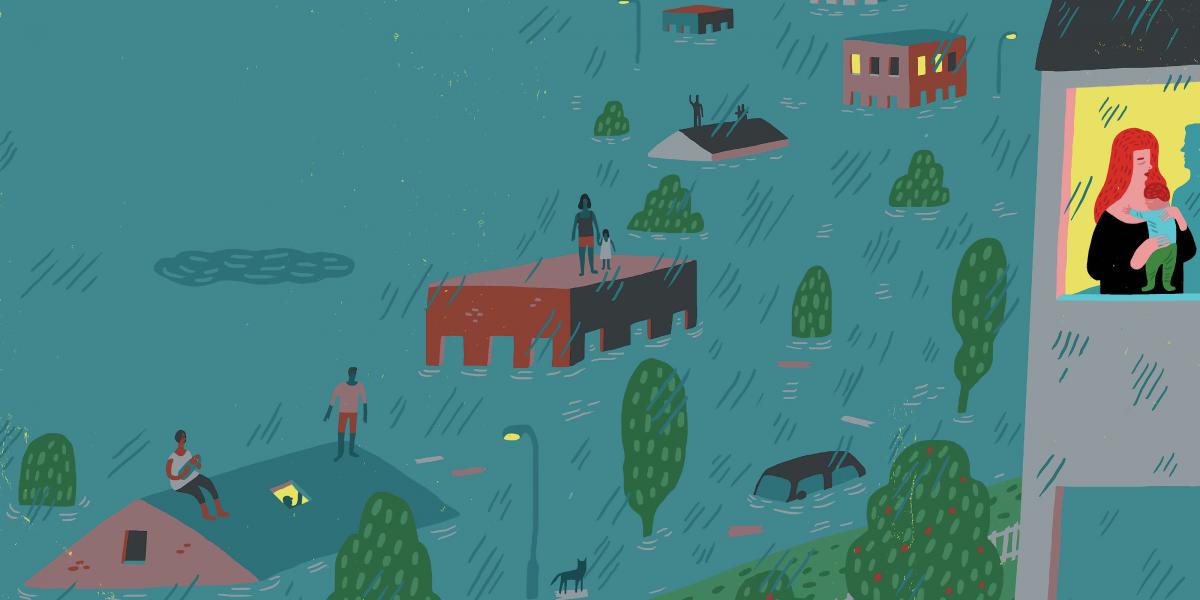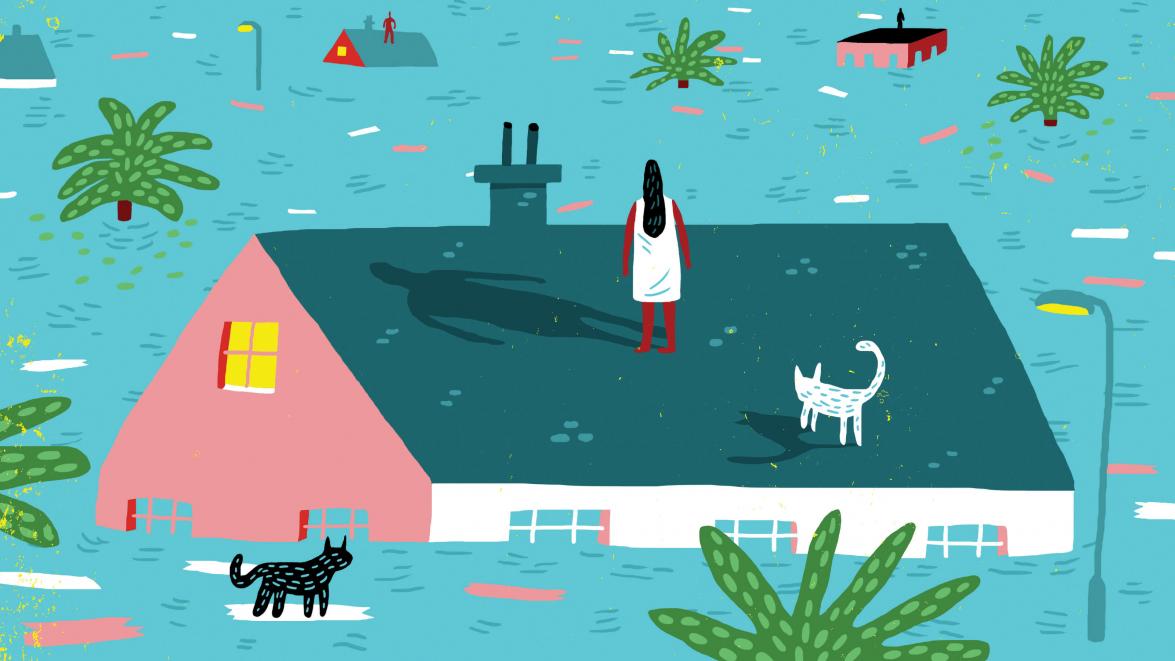Gentrification: Climate Change's Latest Threat
The latest health impact of a warming planet? Climate gentrification—the pricing of vulnerable populations out of their homes.
Hurricane Katrina hit Louisiana in August 2005 with wind speeds of 125 miles per hour. Entire neighborhoods in New Orleans, including the predominantly African-American Lower Ninth Ward, were destroyed. Approximately 80 percent of the city was flooded. At least 400,000 residents—most of them low-income people of color—were displaced.
Genee Smith, an assistant professor in Environmental Health and Engineering, remembers the mixture of astonishment and sorrow she felt as she watched television coverage of the hurricane.
“It was amazing and sad at the same time,” recalls Smith, PhD, MSPH, who was at the time preparing to enter graduate school. She was at once awed by the sheer power of the storm and distressed by the scale of the suffering it wrought.
Now, more than a decade later, Smith is trying to determine whether Katrina is continuing to visit harm upon the Big Easy’s most vulnerable inhabitants.
Anecdotal reports suggest that gentrification spurred by the redevelopment process is displacing even more of the minority and low-income residents who were initially forced from their homes—a phenomenon dubbed “climate gentrification” by Jesse M. Keenan, PhD, JD, MSc, an urban development and climate adaptation researcher at Harvard University’s Graduate School of Design. If true, experts worry that public health could suffer as uprooted individuals contend with heightened stress, disrupted social networks and compromised access to health care and other services.
Smith is therefore trying to figure out whether those reports are accurate. Her work could have implications for cities across the U.S., with New Orleans serving as an important test case.
Activists and journalists are already sounding the alarm over “gentrification by water” in parts of New York and New Jersey that were swamped by Hurricane Sandy in 2012; in Houston, which was deluged by Hurricane Harvey in 2017; and in Miami, where rising sea levels are steadily encroaching on beachfront property.
Smith and doctoral student Kyle Aune are using census data and estimates of floodwater depth to explore the relationship between post-Katrina gentrification and the degree of flooding that the hurricane caused across New Orleans. Their preliminary findings suggest a link between storm-related flooding and shifting neighborhood demographics—confirming something epidemiologists have long known.
“Place matters,” Smith says. “Where you live matters.”
Inordinate Impact
The proximate effects of global warming—record-high temperatures, rising sea levels and the human suffering that ensues from the resulting droughts, floods and other natural disasters—are all too clear. According to the WHO, climate change is expected to cause approximately 250,000 additional deaths per year between 2030 and 2050, including 38,000 from heat exposure and 95,000 from childhood undernutrition.
But what happens in the weeks, months and years after an extreme weather event wreaks havoc on a community?
This is precisely the question that Smith, an epidemiologist who studies the health effects of climate change on vulnerable populations, is trying to answer. Her work fits squarely within the realm of climate justice, a movement that Charles Lee, senior policy adviser on environmental justice at the EPA, describes as seeking “to protect disadvantaged communities disproportionately affected by climate change.”
As Smith explains, the very people who tend to contribute least to climate change—minorities, indigenous groups, those on the lower end of the socioeconomic scale—tend to suffer its effects most severely. Because of where they live, along with their lack of political clout and inadequate access to resources, they are most likely to see their neighborhoods destroyed by storms or to be deprived of food and medicine during a disaster, just as they are least likely to have air conditioning during a heat wave or a car to carry them to safety.
As a result, Smith says, proponents of climate justice recognize that climate change is “not just an environmental issue, but a political issue, a social issue and a racial issue.”
Nowhere is this clearer than in the case of climate gentrification.
Minority and low-income populations have often clustered in particular neighborhoods not by accident, but by design. Discriminatory housing practices, for example, ensured that people of color were historically excluded from some neighborhoods and confined to others.
When such communities must relocate because of climate change, they are subjected to a double injustice: the first resulting from intentional discrimination that limits their housing options, the second from a natural disaster that they had little hand in creating but to which they have been rendered uniquely susceptible.
The consequences for public health are potentially far-reaching.
The CDC notes that the health effects of displacement include limited access to everything from affordable and safe housing to healthy food choices and transportation options. In a 2009 article in the journal Disasters, Lori Uscher-Pines, PhD ’08, a former postdoctoral fellow at the School who is now a policy researcher at the RAND Corporation, wrote that “even displacement within the same general vicinity disrupts social networks, usual sources of medical care and pharmaceuticals, and access to social services and regular routines.” Numerous studies show that those forced from their homes by disaster are at higher risk of developing mental health problems, and the elevated stress levels they experience can lead to a variety of harms. As Aune points out, high levels of the stress hormone cortisol among pregnant women can even lead to negative health outcomes in their children.
“There are immediate effects to health and safety associated with extreme weather events, but something like gentrification is going to have effects for generations,” he says.
Higher Ground
In practice, climate gentrification looks like gentrification by any other means: A neighborhood’s population tilts from lower to higher socioeconomic status, new businesses and amenities appear and housing prices increase, driving longtime residents to seek cheaper pastures. With climate gentrification—prompted by extreme weather—the entire process is greatly accelerated.
In one scenario, opportunistic real estate developers swoop in to damaged neighborhoods, buying up inexpensive land and building resilient luxury housing. That drives up market rates, forcing low-income residents to move elsewhere.
In another, affluent residents of pricey coastal neighborhoods, faced with rising sea levels, decamp for higher ground, snapping up less expensive properties inland and pricing out the disadvantaged communities residing there.
Many believe this is occurring in Miami, where housing prices are soaring in historically black neighborhoods such as Liberty City and Little Haiti that sit far from the flood-prone beaches. Keenan and his colleagues at Harvard recently published research in Environmental Research Letters demonstrating that the appreciation in price of single-family dwellings across Miami-Dade County is tied to elevation, with higher-elevation properties appreciating more quickly than lower-elevation ones. And anecdotal evidence suggests that certain neighborhoods are feeling the heat more than others. A 2017 study by the online real estate database company Zillow, for instance, predicted that Little Haiti, a community founded by Haitian refugees, would be the “hottest neighborhood” of that year. Tellingly, while the area remains mostly black, the number of Haitian Americans is declining.
Even well-intentioned efforts to render vulnerable areas more resilient to climate change by rebuilding them to higher (and greener) standards can lead to climate gentrification.
New York City, for example, is spending hundreds of millions of dollars to renew areas that were affected by Sandy to ensure that they will be better able to weather the next storm: expanding green space, enacting stricter building codes, erecting seawalls. But those improvements drive up housing costs, leaving residents of lesser means little choice but to relocate.
“Green development is itself becoming an indicator of gentrification,” Smith says.
The Measure of Change
Despite the abundant anecdotal evidence for climate gentrification and growing scholarly interest in the topic, the field is nascent, and there is little data that public health experts and officials can use to inform policy.
“You can make virtuous moral arguments, but you also need hard data to back them up,” Aune says.
In New Orleans, Smith found an ideal source for such data, and for testing the hypothesis that the flooding caused by an extreme weather event could drive gentrification over time.
Katrina provided local developers with what Aune describes as “a natural wrecking ball” for razing and redeveloping existing neighborhoods. And the storm struck long enough ago for measurable changes in gentrification to have occurred.
What’s more, the U.S. Geological Survey had conducted a high-resolution topological survey of New Orleans before Katrina hit. By combining the elevation data from that survey with measurements from a water-level gauge on Lake Pontchartrain, which provides a convenient proxy for floodwater levels in the city, the agency developed highly accurate estimates of floodwater depth across Orleans Parish. Smith and Aune therefore had access to a ready-made indicator of flooding severity.
Figuring out how to measure gentrification was trickier.
“It’s not like blood pressure, where there is a widely agreed-upon way of calculating and measuring it,” Aune says. Instead, previous studies have relied on indicators ranging from median rents to changes in ethnic and racial composition. In a study published in 2014 in the Journal of Urban Health that examined the association between gentrification and preterm birth in New York City, the researchers used a combination of different indicators to come up with a nuanced measure of gentrification. Smith and Aune decided to take that approach.
They examined changes that occurred across various measures from 2000 to 2010, and then again from 2000 to 2015. Using statistical methods, they developed a “gentrification index” that puts a number on the overall shift in social and economic status that has occurred in a given part of the city. By combining gentrification index scores with floodwater data, the researchers hope to unpack the relationship between flooding and gentrification across New Orleans.
Though still in its early stages, their analysis already indicates a relationship between flood severity and subsequent gentrification.
Once that correlation has been firmly established, Smith would like to see if it varies by group. Does climate gentrification only occur in African-American neighborhoods, for example, or in ones characterized by low socioeconomic status?
Aune is currently developing a statistical tool that could be used to estimate the risk that a neighborhood will gentrify after flooding. “Then you could say, ‘For every foot of flooding, you are 30 percent more likely to experience gentrification,’” he says.
City planners, emergency management officials and others who prepare for and respond to events like Katrina could use such a tool to tailor their funding and planning efforts to keep vulnerable populations in their neighborhoods, staving off climate gentrification and its attendant negative effects on public health.
But if climate gentrification is sparked by environmental factors, it is exacerbated by the fact that disadvantaged communities often lack the means to advocate on their own behalf. For example, minority and low-income groups tend to be underrepresented on community zoning boards. When developers seek permits to reshape neighborhoods, those groups lack a voice.
“If we are able in our analysis to show that these situations disproportionately affect less-educated people, or that racial and ethnic differences influence how they are affected by gentrification, then maybe we can change the sociodemographic profile that makes them susceptible,” says Aune.
Ultimately, Smith says, coming to grips with climate gentrification means tackling the same social and economic inequities that drive so many disparities in public health. And that means paying attention to the unique needs and challenges of those most at risk.
“We are not all on an equal playing field,” she says. “And as an individual who works in public health, I fail people—I fail society—if I don’t focus on equity.”

